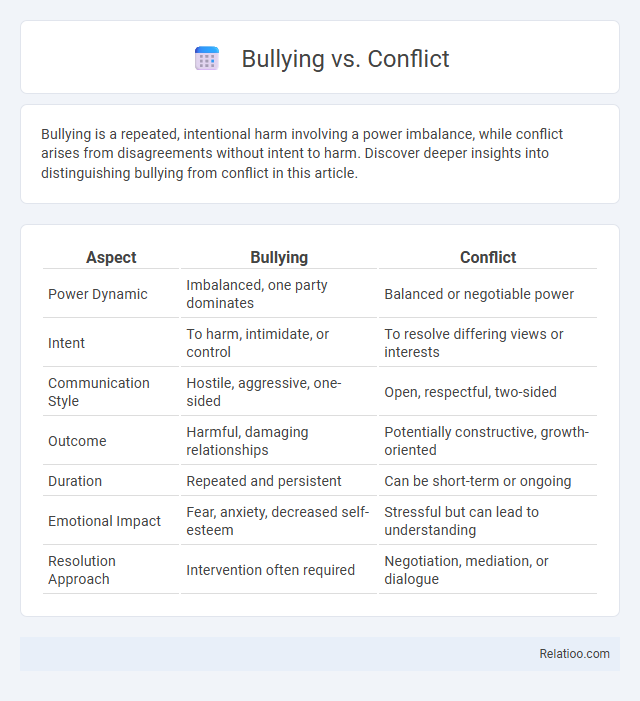Bullying is a repeated, intentional harm involving a power imbalance, while conflict arises from disagreements without intent to harm. Discover deeper insights into distinguishing bullying from conflict in this article.
Table of Comparison
| Aspect | Bullying | Conflict |
|---|---|---|
| Power Dynamic | Imbalanced, one party dominates | Balanced or negotiable power |
| Intent | To harm, intimidate, or control | To resolve differing views or interests |
| Communication Style | Hostile, aggressive, one-sided | Open, respectful, two-sided |
| Outcome | Harmful, damaging relationships | Potentially constructive, growth-oriented |
| Duration | Repeated and persistent | Can be short-term or ongoing |
| Emotional Impact | Fear, anxiety, decreased self-esteem | Stressful but can lead to understanding |
| Resolution Approach | Intervention often required | Negotiation, mediation, or dialogue |
Understanding Bullying vs Conflict: Key Differences
Bullying involves repeated, intentional aggression intended to harm, intimidate, or control a target, often marked by a power imbalance, while conflict refers to a mutual disagreement or clash between parties with equal power. Understanding bullying vs conflict is crucial because conflicts can be resolved through dialogue and compromise, but bullying requires intervention to protect your well-being. Recognizing the key differences helps identify harmful behaviors early and implement appropriate responses for a safer environment.
Defining Bullying: Characteristics and Patterns
Bullying is characterized by repetitive, intentional aggressive behavior aimed at causing harm or discomfort to a less powerful individual, distinguished by a power imbalance that is not present in typical conflicts. Unlike conflicts, which involve mutual disagreement or opposition between parties of relatively equal power, bullying involves a persistent pattern of targeting a specific individual with verbal, physical, or psychological abuse. Key patterns include repetition over time, deliberate intent to hurt, and an imbalance of power that reinforces the victim's vulnerability and the bully's dominance.
Defining Conflict: Nature and Dynamics
Conflict involves a disagreement between individuals or groups where both parties perceive incompatible goals or interests, often arising from communication breakdowns or differing values. Unlike bullying, which is characterized by intentional, repeated aggression and power imbalance, conflict can be constructive when managed effectively, facilitating growth and understanding. Understanding the nature and dynamics of conflict helps you navigate disputes without escalating them into harmful behavior.
Common Causes of Bullying and Conflict
Bullying and conflict both arise from interpersonal tensions, but bullying is characterized by a power imbalance and repetitive aggressive behavior, whereas conflict typically involves a mutual disagreement without ongoing domination. Common causes of bullying include the desire for control, social status seeking, and underlying insecurities, while conflicts often stem from misunderstandings, differing values, or competition for resources. Recognizing these distinct causes helps in developing targeted interventions to reduce bullying and manage conflicts effectively.
Identifying Signs: Bullying vs Conflict in Action
Identifying signs of bullying versus conflict hinges on intent, repetition, and power imbalance; bullying involves deliberate harm, consistent targeting, and an imbalance where one party exerts control. Conflict is usually a mutual disagreement without ongoing aggression or power disparity, often resolved through communication. Your ability to recognize these differences ensures effective intervention and support for those involved.
Impact on Individuals: Emotional and Psychological Effects
Bullying causes severe emotional and psychological effects on individuals, including anxiety, depression, and lowered self-esteem, often leading to long-term trauma. Conflict typically involves mutual disagreement and can result in stress but generally lacks the persistent harm and power imbalance found in bullying. Your well-being is at greater risk in bullying situations due to repeated aggression aimed at control and humiliation, distinguishing it from occasional conflicts.
Roles of Bystanders: Intervention and Prevention
Bystanders play a critical role in differentiating bullying from conflict by either escalating or de-escalating situations through their actions. Your intervention can prevent the reinforcement of bullying behaviors by supporting victims and discouraging aggressors, whereas passive bystanders may unintentionally enable conflict to evolve into bullying. Empowering bystanders with strategies for intervention significantly reduces the occurrence and impact of bullying in schools and communities.
Effective Strategies for Addressing Bullying
Effective strategies for addressing bullying focus on creating a safe and supportive environment through clear anti-bullying policies, consistent enforcement, and education programs that teach empathy and conflict resolution skills. Implementing restorative practices helps repair harm and foster accountability among students, distinguishing bullying from typical conflicts based on power imbalance and intent to harm. Engaging parents, educators, and students in open communication channels strengthens prevention and intervention efforts, ensuring tailored support for victims and behavior modification for perpetrators.
Conflict Resolution Techniques in Schools and Workplaces
Conflict resolution techniques in schools and workplaces focus on addressing disagreements constructively, emphasizing active listening, empathy, and problem-solving to restore positive relationships. Bullying involves repeated harmful behavior with intent to dominate, requiring clear anti-bullying policies, reporting systems, and support for victims, differing from typical conflicts. Your understanding of these distinctions helps implement targeted strategies that promote safe, respectful environments and effectively resolve conflicts without escalating to bullying.
Building Respectful Environments to Prevent Both
Building respectful environments requires clear differentiation between bullying and conflict, as bullying involves repeated, intentional harm, while conflict is a natural disagreement between parties. Implementing consistent anti-bullying policies, promoting empathy, and fostering open communication help prevent harmful behaviors and resolve conflicts constructively. Schools and workplaces that prioritize respect and inclusivity significantly reduce incidents of bullying and improve overall community well-being.

Infographic: Bullying vs Conflict
 relatioo.com
relatioo.com